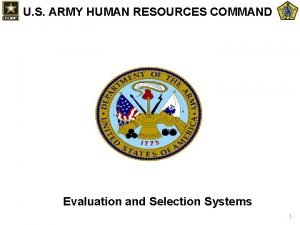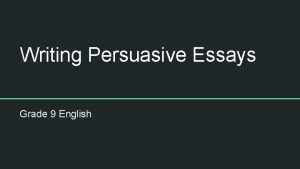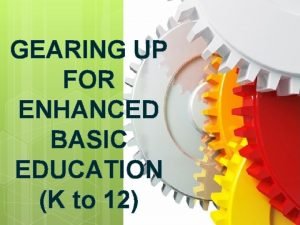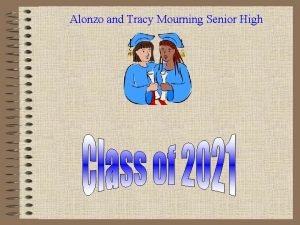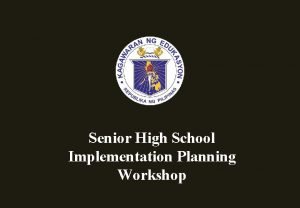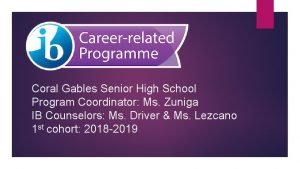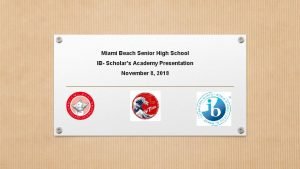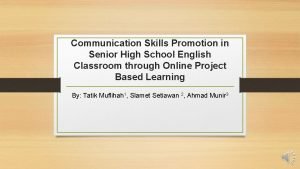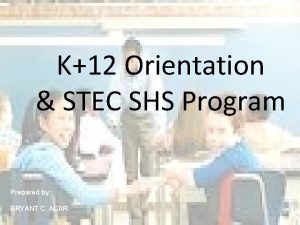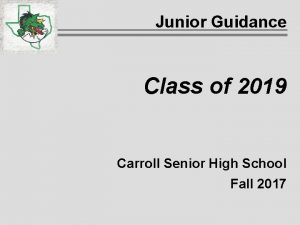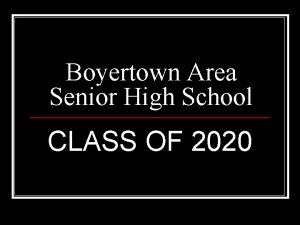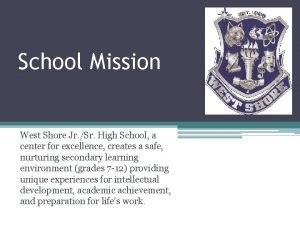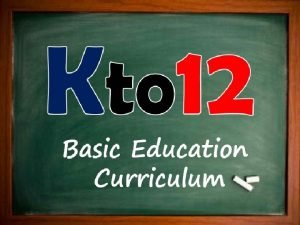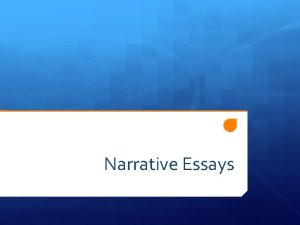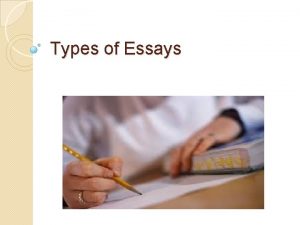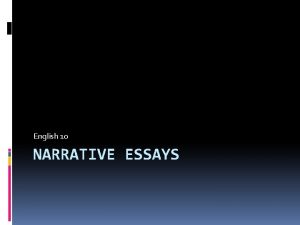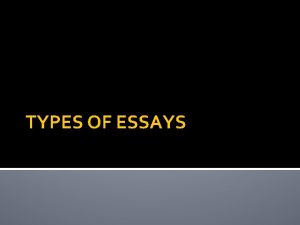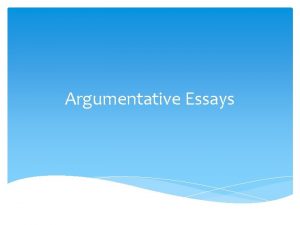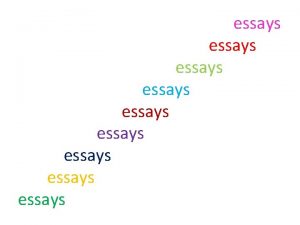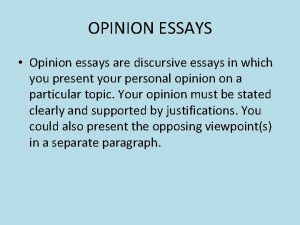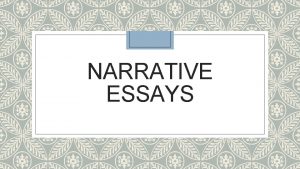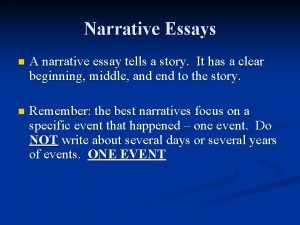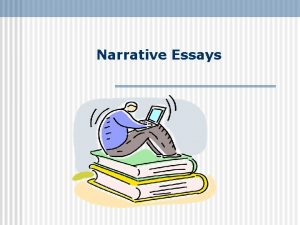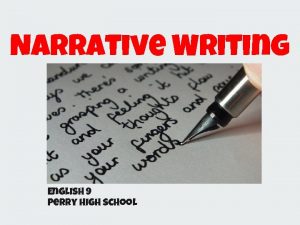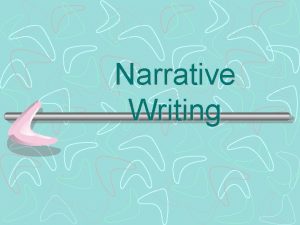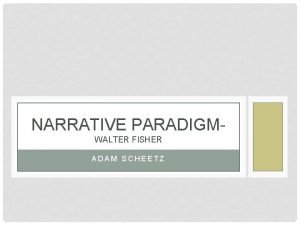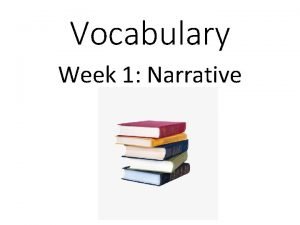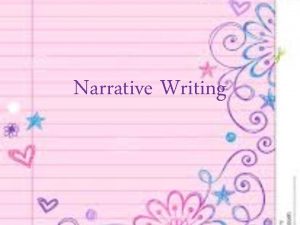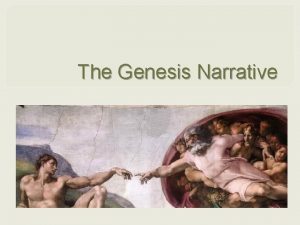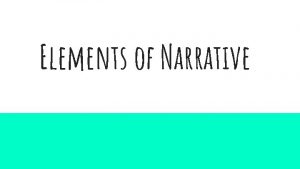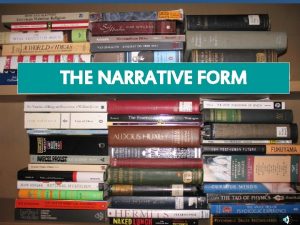Essays Senior High English Types of Essays Narrative


































- Slides: 34

Essays Senior High English

Types of Essays � Narrative – exposition that focuses on story to develop its thesis and message � Personal essay – exposition developed though personal examples (not global or scientific) � Descriptive – an essay which develops a thesis through vivid description, imagery, or comparison

Types of Essays � Argumentation – an essay which depends on logic and evidence to substantiate a point. It is characterized by global or scientific examples, evidence, facts. � Persuasion – an essay which is characterized as more informal and emotional that argumentation. While evidence is still logical and rational in an essay of this nature it depends less on authorities and facts and but on opinions supported with personal examples developed through greater emotional commitment and usually a call to action.

5 Types of Expository Essays Expository essays are characterized on the basis of their method of development (means by which a paragraph or essay is developed): � Example and Illustration � Cause and Effect � Classification and Division � Process Analysis � Comparison and/or Contrast

Purpose: The Reason for Writing The reason behind the writing or the visual which is always stated as “to ______? _______. ” ◦ To explain (exposition) ◦ To entertain (narration; film) ◦ To describe/to recreate (description/poetry)

Audience � The intended reader: reader defined by the author, the message and the diction (word choice) Avoid “everyone” – try to be specific ◦ ◦ ◦ Young people Parents Government Daycare workers Store owners Consumers

Thesis � The main idea or subject of a report, essay, or argument, stated by the reader (not writer) � Thesis statement: a sentence or two stating the main idea or subject of a report, essay, or argument. The proposition to be maintained or proved in an essay, speech or other nonfiction work by supporting evidence, examples, and arguments is usually clearly stated in the introduction.

Topic Sentence � Expresses paragraph the main idea contained in the � The topic sentence does for a paragraph what a thesis does for a complete essay. � It is often placed as the first sentence in the paragraph.

Methods of Introduction 7 different types of openings: 1. 2. 3. 4. 5. 6. 7. Definition Relevant fact Unusual detail Rhetorical Question Personal experience Short narrative or example Direct statement of purpose/thesis statment

Tone � The author's attitude towards his subject/characters. � Most frequently noted by the diction (word choice)

Examples of Tone � Angry � Sympathetic � Sarcastic � Sentimental � Silly � Pitiful � Sad � Afraid � Happy � Sharp � Cold � Happy � Detached � Cynical � Upset � Joking � Wonderment � Childish � Confused � Humorous � Thoughtful � Apologetic � Joyful � Sweet � Objective � Disgust � Mocking � Bitter � Arrogance � Vexed � Nostalgic � Horrific � Proud � Furious

Diction = author’s word choice � Examine the dictionary meaning of words – denotation � Figure out the implied meaning or the connotation

Diction There is no single, correct diction in the English language; instead, you choose different words or phrases for different contexts: To To a friend a child the police an employer "a screw-up" "a mistake" "an accident" "an oversight”

Style: Formal � Usually rational in tone � 3 rd person point of view � Lengthy and carefully constructed paragraphs and sentences � Sentence fragments are not acceptable � Carefully punctuated and capitalized � Precise diction (words) � Factual and well documented � No contractions or abbreviations � Used in formal situations

Style: Informal � Sounds more like a conversation � 1 st and 2 nd person point of view � Sentences and paragraphs are often shorter � Compound and simple sentences used frequently � Sentence fragments might be employed for emphasis � Vocabulary is common (everyday words and expressions) � Less care is taken with punctuation � Use of contractions and abbreviations � Opinions and personal evidence

Unity �A sense of oneness in writing � Everything in the paragraph/essay contains only relevant information to the paragraph/essay

How Unity is Achieved: � Clear thesis statement � Each part of the essay relates to thesis � Topic sentences in body paragraphs relate to thesis � Generalizations are supported with evidence – use of examples � Methods to conclude

Methods to Conclude � Climax � Call to action (for persuasive essays) � Thesis restatement – thesis is reworded � Closing by return – the writer refers to something from the opening � Summary – a main point or two from each body paragraph

Coherence � The flow of ideas or arrangement of ideas in a logical sequence; it is achieved through: 1. Transitions 2. Pronoun Reference

1. Transitions � Words or phrases that help to achieve a smooth carry over within and between sentences, paragraphs, and sections of writing.

Transitions words (sequence): in the first place, second, finally, etc. � Temporal references (time) – last week, seconds later, then, etc. � Spatial references (space) – in front of, behind, etc. � General connectives (coordinating conjunctions) – and, but, or, etc. � Subordinating conjunctions – because, hence, consequently, however, as a result of, etc. � Framing

Transitions To Add: and, again, and then, besides, equally important, finally, furthermore, moreover, in addition, first (second, etc. ), To Compare: but, yet, on the other hand, however, nevertheless, on the other hand, on the contrary, by comparison, compared to, balanced, although, conversely, meanwhile, after all, in contrast, although this may be true To Prove: because, for, since, for the same reason, obviously, evidently, furthermore, moreover, besides, indeed, in fact, in addition To Show Time: immediately, thereafter, soon, after a few hours, finally, then, later, previously, formerly, first (second, etc. ), next, and then

Transitions To Emphasize: definitely, obviously, in fact, indeed, in any case, absolutely, positively, naturally, unquestionably, without a doubt, certainly, undeniably, without reservation To Show Sequence: first, second, third, and so forth. following this, at this time, now, at this point, afterward, subsequently, finally, consequently, previously, thus, therefore, hence, next, and then, soon To Give an Example: for example, for instance, in this case, take the case of, to demonstrate, to illustrate, as an illustration, to illustrate To Summarize or Conclude: in brief, on the whole, summing up, to conclude, hence, therefore, accordingly, thus, as a result, consequently

Examples of Transitions �A good education is important for a number of reasons. First, it broadens your mind. Second, you learn new things. Finally, you prepare for the future. ◦ (framing or sequence transitions)

Examples of Transitions like autumn, and yet autumn is a sad time of the year, too. The leaves turn bright shades of red and the weather is mild, but I can't help thinking ahead to the winter and the ice storms that will surely blow through here. In addition, that will be the season of chapped faces, too many layers of clothes to put on, and days when I'll have to shovel heaps of snow from my car's windshield. �I

2. Pronoun Reference Using a pronoun to refer to a noun in an earlier phrase or sentence to show linkage of ideas without being monotonous or awkwardly repeating nouns. Example: The students brought their books to class so that they could do their assignments.

Pronoun Reference Example: When scientific experiments do not work out as expected, they are often considered failures until some other scientist tries them again. Those that work out better the second time around are the ones that promise the most rewards.

Emphasis is the means by which important elements are made to stand out in a paragraph or essay: 1. Forceful topic sentences 2. Effective closing sentences (clincher statements) 3. Placement of key ideas near the beginning and end 4. Elaboration with supporting ideas 5. Comparison and contrast 6. Purposeful repetition of words and phrases 7. Repetition and restatement of sentences

Emphasis � 8. Parallel structure – the use of similar grammatical components within a sentence to show similar relationship of thought within and between sentences. Example: The books, the notes, and the photos were all evidence that he had been there.

Emphasis More examples of parallel structure: Mary likes hiking, swimming, and riding a bicycle. The coach told the players that they should get a lot of sleep, that they should not eat too much, and that they should do some warm-up exercises before the game.

Emphasis 9. Repetition of Key Words or Synonyms (words with similar ideas) � The repeated use of a key word from thesis or topic sentence. When a writer feels he/she has overused the key word, a synonym (similar meaning) can be used. � Its purpose is to show the connection of the key words within an essay and to avoid monotony.

Emphasis Repetition of a Key Word Example: The problem with contemporary art is that it is not easily understood by most people. Contemporary art is deliberately abstract, and that means it leaves the viewer wondering what he and she is looking at.

Emphasis Synonyms words that have essentially the same meaning, and they provide some variety in word choice, helping the reader to stay focused on the idea being discussed. Example: Myths narrate sacred histories and explain sacred origins. These traditional narratives are, in short, a set of beliefs that are a very real force in the lives of the people who tell them.

The End!!!
 Ncoer senior rater narrative examples
Ncoer senior rater narrative examples Paragraph examples grade 9
Paragraph examples grade 9 Scarborough high school principal
Scarborough high school principal Gearing up for the future (senior high school)
Gearing up for the future (senior high school) Dayuan international senior high school
Dayuan international senior high school Sdsu wue
Sdsu wue Alonzo and tracy mourning senior high
Alonzo and tracy mourning senior high Alfred adler was a neo freudian who coined the term
Alfred adler was a neo freudian who coined the term Ira pernick
Ira pernick Miami senior high
Miami senior high Humss sample schedule
Humss sample schedule Humss course
Humss course Miami sunset high school
Miami sunset high school Erf.
Erf. Strand in senior high
Strand in senior high Coral gables ib program
Coral gables ib program Gibbs high school wrestling
Gibbs high school wrestling High school fo
High school fo Naviance potomac senior high school
Naviance potomac senior high school Miami beach senior high school dr. maria t. rodriguez
Miami beach senior high school dr. maria t. rodriguez Socartive
Socartive Kalamunda senior high school
Kalamunda senior high school Communication skills of senior high school students
Communication skills of senior high school students Welcome to senior year
Welcome to senior year Shippensburg area senior high school
Shippensburg area senior high school Miami killian senior high school rating
Miami killian senior high school rating Strand shs
Strand shs Carroll senior high school counselors
Carroll senior high school counselors Boyertown program of studies
Boyertown program of studies Westshore junior senior high school
Westshore junior senior high school Palace senior high school
Palace senior high school Course in senior high school
Course in senior high school Senior high school subjects (per semester)
Senior high school subjects (per semester) Example of importance of the study
Example of importance of the study Parma high school athletics
Parma high school athletics
